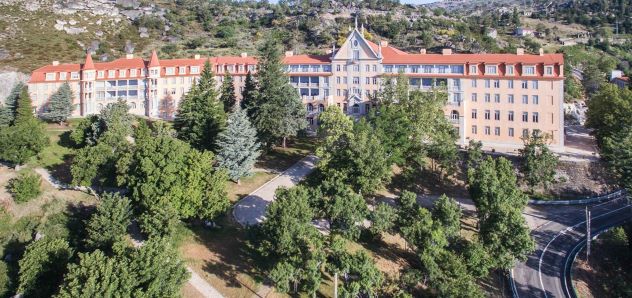 Creepy
Creepy  Creepy
Creepy  Technology
Technology 10 Scientific Breakthroughs of 2025 That’ll Change Everything
 Our World
Our World 10 Ways Icelandic Culture Makes Other Countries Look Boring
 Misconceptions
Misconceptions 10 Common Misconceptions About the Victorian Era
 Mysteries
Mysteries 10 Strange Unexplained Mysteries of 2025
 Miscellaneous
Miscellaneous 10 of History’s Most Bell-Ringing Finishing Moves
 History
History 10 Great Escapes That Ended Right Back in Captivity
 Weird Stuff
Weird Stuff 10 Fascinating Things You Might Not Know About Spiders
 Food
Food 10 Everyday Foods You Didn’t Know Were Invented by the U.S. Military
 History
History 10 Odd Things Colonial Americans Kept at Home
 Creepy
Creepy 10 More Representations of Death from Myth, Legend, and Folktale
 Technology
Technology 10 Scientific Breakthroughs of 2025 That’ll Change Everything
 Our World
Our World 10 Ways Icelandic Culture Makes Other Countries Look Boring
Who's Behind Listverse?

Jamie Frater
Head Editor
Jamie founded Listverse due to an insatiable desire to share fascinating, obscure, and bizarre facts. He has been a guest speaker on numerous national radio and television stations and is a five time published author.
More About Us Misconceptions
Misconceptions 10 Common Misconceptions About the Victorian Era
 Mysteries
Mysteries 10 Strange Unexplained Mysteries of 2025
 Miscellaneous
Miscellaneous 10 of History’s Most Bell-Ringing Finishing Moves
 History
History 10 Great Escapes That Ended Right Back in Captivity
 Weird Stuff
Weird Stuff 10 Fascinating Things You Might Not Know About Spiders
 Food
Food 10 Everyday Foods You Didn’t Know Were Invented by the U.S. Military
 History
History 10 Odd Things Colonial Americans Kept at Home
10 More Haunted Landmarks around the World
Most eerie tales are set in scary locations and include creepy details such as unseen fingers about to trace a burning image on your cheek or loud unexplained thumps sounding up from various parts of the house, making it impossible to fall asleep. Others are based on old urban legends about killers with hooks for hands or obscure small towns that never give up their dead.
However, famous places also have a scary tale or two to offer. Some of the most well-known landmarks around the world have a dark side, too, and their history often includes deeply disturbing and sometimes haunting stories.
Related: Top 10 Famous Haunted Landmarks You Didn’t Know Were Haunted
10 Ancient Ram Inn
In Wotton-under-Edge, around 40 minutes from Bristol, you will find the Ancient Ram Inn. It has been called the most haunted house in Britain and has existed since 1145. The building was constructed on a pagan burial ground and purportedly lies on ley lines that are connected to Stonehenge.
The Ancient Ram Inn was a home for workers and slaves who built the nearby St. Mary’s Church, and it is believed that because water streams had to be diverted around the church premises, a portal opened up for dark energy to be released. At one point, the house also belonged to a priest before being sold in 1968.
The new owner, John Humphries, had a rude awakening the first night he slept at the property. He claimed to have been grabbed and dragged across his bedroom by “demonic forces.” Afterward, he searched in and around the house for signs of what may have caused his terrifying experience. He found evidence of ritual sacrifices as well as the skeletal remains of children who’d possibly been murdered with daggers.
Humphries’s family left him, but he remained at the Ancient Ram Inn until his death in 2017. Several spirits, according to reports, still roam the house, however. They include a witch who had been burned at the stake, dark monks, and a Roman Centurion.[1]
The Ancient Ram Inn is now owned by John Humphries’s daughter, Caroline. She now opens the doors to researchers, paranormal enthusiasts, and tourists willing to enter the centuries-old haunted building.
9 Africana Library
The Kimberley Public Library was opened on July 23, 1887. In 1984, it was converted to the Africana Research Library and soon became one of the best research libraries in Southern Africa. Situated in Kimberley in the Northern Cape province of South Africa, it has long since had the distinction of being one of the most haunted buildings in the country.
The first librarian at the library whiled away his days by cooking up a pricing scam but was soon caught. Bertrand Dyer dealt with the scandal by swallowing arsenic in 1908, and he endured a harrowing three days before succumbing to the poison.
He never left his post, however, with visitors to the library claiming that they’ve witnessed his ghost pacing the various halls and also rearranging some of the thousands of books that can be found there. It has also been said that if you cannot find a particular book, you should just shout out the title, and Dyer will find it for you.[2]
8 Lawang Sewu
Lawang Sewu translates to “Thousand Doors” in Javanese and is a colonial-era building that served as the headquarters of the Dutch East Indies Railway Company in Semarang, Central Java. The structure has 600 windows and incorporates numerous doors and arcs within its design, making it somewhat of a labyrinth. The complex consists of a number of buildings named A, B, C, and D.
During World War II, Japanese soldiers occupied Lawang Sewu and turned the B building basement into a makeshift prison. Many prisoners held here were murdered, and it has been reported that their restless, headless spirits wander the buildings in the Lawang Sewu complex. The spirit of a Dutch woman who committed suicide has also reportedly been seen roaming the place. The Indonesian government made an effort to clean up the building and rehabilitate its reputation as a non-creepy tourist destination. But ghost tours still remain the most lucrative activity.[3]
7 Masada Fortress
The King of Judea, Herod the Great, built Masada as a castle complex at the edge of the Judean Desert in the last century BC. In the first century AD, the ancient Romans took over Judea, and the complex became a fortress for the Jews. When the Romans finally took over Masada, most of the women and children who hid inside the fortress committed suicide.
During the Byzantine period, a group of monks built a hermetic monastery at the site, and afterward, the area remained uninhabited for around 13 centuries until it was rediscovered in 1828. The site was declared a national park in 1966, and a cable car came into operation in 1977. Today the Masada fortress is a beloved pilgrimage and tourist spot where visitors can take in sights such as the storerooms that held the Masada inhabitants’ food and weapon supplies as well as palaces, Roman bathhouses, and more.
However, those who committed suicide within the fortress walls are still making their presence known today. As people wander around, taking photographs and admiring the ancient structure, some hear the screams of those who died before the Romans could get hold of them. Others witness the apparitions of these unhappy souls, forever trapped in the place they died.[4]
6 La Noria Ghost Town and Cemetery
In the Atacama Desert in Chile lies the long-abandoned ghost town, La Noria. In 1826 it was a flourishing saltpeter mining town and home to thousands of people who attended the local church, frequented the local shops, and sent their children to the local school.
Sadly, the town was severely affected by its competition, as well as a devastating fire that broke out in 1901. Then, during WWI, a synthetic alternative to saltpeter was discovered, which delivered the death knell to La Noria. Soon its inhabitants began leaving, many abandoning their possessions in search of a better future.
La Noria and its namesake cemetery were hit hard by looting after the town was abandoned and several coffins and human bones still lie exposed. A chilling urban legend has it that the souls connected to the disturbed coffins and bones have become angry at how their last resting place has been disrespected. As the sun sets, they rise from their broken graves and make their way to the lonely ghost town of La Noria in a silent protest. Visitors to the town ruins have reported witnessing this procession and hearing screams and disembodied voices echoing through the empty structures.[5]
5 Hotel Union Øye
The village of Øye boasts one of the most beautiful hotels in the whole of Europe. The Hotel Union Øye is nestled in the Sunmmøre Alps in Norway and has seen many a famous visitor, including Queen Wilhelmina of the Netherlands, King Haakon VII of Norway, and Arthur Conan Doyle.
The hotel is also well known for its Blue Room that is said to have been frequented by a young servant girl named Linda and a German officer in the 1800s. The officer was married, and when he asked his wife for a divorce, she refused, and he killed himself soon after. When Linda heard of the tragedy, she headed down to the nearby fjord and drowned herself.
Nowadays, patrons of the hotel have reported hearing loud sobbing and waking up to the ghost of Linda sitting in their room. Guests who wish to experience the Blue Room are given a silver bowl of garlic to ward off Linda’s ghost. However, if they are up for a ghostly adventure, they should leave the bowl outside the door.[6]
4 Village of Ghostly Voices
In 1790, Obadiah Higginbotham and Johnathan Randall relocated their families from Rhode Island to the woods of the Ragged Hills section of Pomfret, Connecticut. They named the settlement Bara-Hack (which means breaking of bread) to celebrate their Welsh heritage.
The two men started a company called Higginbotham Linen Wheels that supplied the surrounding areas with flax spinning. Bara-Hack soon flourished and became a village in its own right, including a mill and waterwheel. It also had grand homes, slave quarters, and a graveyard. Soon after the deaths of the founding families, however, Bara-Hack was slowly abandoned. By the time the Civil War broke out, there was no one left.
Over the years that followed, the site became a popular paranormal investigation spot. Those brave enough to visit it at night reported seeing the ghost of a baby and a floating bearded face in the cemetery. There have also been reports of the sounds of horse-drawn buggies and long-dead farm animals echoing in the dark. Bara-Hack is now known as the “village of ghostly voices” and is currently closed to the public as it lies on private property.[7]
3 Pousada Serra da Estrela

The Pousada Serra da Estrela is a stunning 5-star hotel in Portugal that offers all you could possibly want in a hotel visit as well as breathtaking views of the Serra da Estrela mountain range.
It wasn’t always the luxury holiday destination it is today, however. Built in 1936, the building started out as a treatment facility for railway workers who suffered from terminal illnesses. At one point, it was leased to the Portugal society of sanitoriums, and it became a facility for all patients who needed treatment. Unfortunately, by 1980, most of the patients had died, and the sanatorium was closed down. Soon rumors started making the rounds of the souls of the dead patients haunting the building.
The rumors still abound, with hotel patrons reportedly seeing the spirits of those who died of tuberculosis wandering the lush halls and corridors at night.[8]
2 Witkowice Forest
Poland is well-known around the world for its stunning cities, castles, and a horrible remnant of Nazi Germany: Auschwitz. Here you will experience hospitability like just about nowhere else, along with fantastic food and great vodka.
The country also has a dark side in the form of several creepy and haunted buildings. These include the Skull Chapel, the haunted asylum in Warsaw, and the Wieliczka Salt Mine. The ghosts are not confined to buildings, though, as the many reports of spooky goings-on in the Witkowice forest attest.
In 2001, nine local students planned an overnight stay in the forest. At around 8:30 that night, they ran into an old man who warned them not to enter the forest, but the students scoffed at him and went into the woods anyway. They were never seen again. It has been rumored that friends of these students undertook their own search because the police were “reluctant” to start an investigation. During their search, they found a camera that allegedly belonged to the missing students. After developing the pictures, they saw the blurred figures of the students in the forest enveloped in a thick mist. The group of friends also discovered that the area of Witkowice was once the site of a massive fire and that many residents died in the forest under strange circumstances.
This story has been compared to the horror film The Blair Witch Project because of their similarities. The students remain missing to this day, with rumors swirling that a “deity” that lives in the forest and produces a thick green mist killed them.[9]
1 Obvodny Canal
Obvodny Canal is the longest canal in Saint Petersburg, Russia. It was dug between the late 1700s and early 1800s but eventually became too shallow for large crafts to navigate. These days, only small boats are allowed to use it, and it has garnered a solid reputation for being haunted. The concrete-lined canal has come to be known as the Suicide Canal because of the vast number of suicides and suicide attempts that take place there.
Those who survived a suicide attempt have reported feeling an invisible force pulling them into the water. Some even claimed to have seen a woman dressed in white floating below the surface of the water before vanishing in the blink of an eye.
Back in the late 18th century when the canal was in the early stages of being built, workers often complained of bad headaches, and some had sudden violent outbursts for no reason. Some believe that the workers were afflicted by a curse because they dug the canal through an ancient pagan graveyard. It is no wonder then that the canal is still regarded as one of the most haunted places in Russia.[10]








